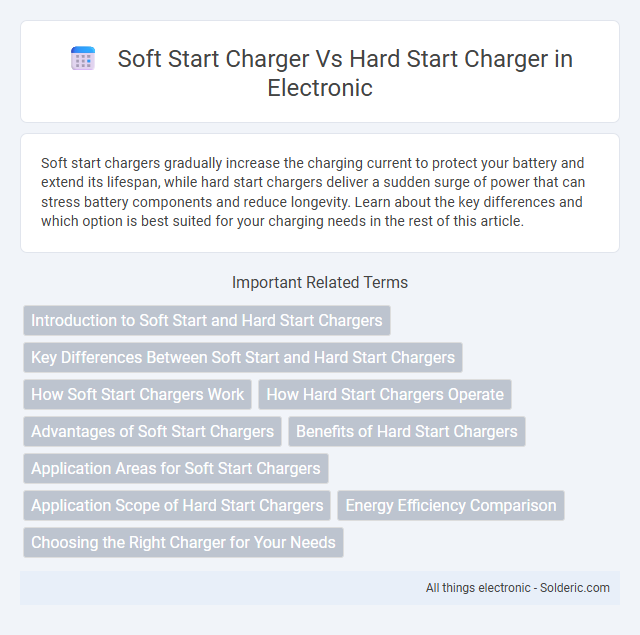Soft start chargers gradually increase the charging current to protect your battery and extend its lifespan, while hard start chargers deliver a sudden surge of power that can stress battery components and reduce longevity. Learn about the key differences and which option is best suited for your charging needs in the rest of this article.
Comparison Table
| Feature | Soft Start Charger | Hard Start Charger |
|---|---|---|
| Starting Method | Gradually ramps up current | Instant full current at start |
| Inrush Current | Low to moderate | High peak current |
| Battery Stress | Minimized, extends battery life | Higher stress, can reduce battery lifespan |
| Charging Efficiency | Steady and controlled | Fast initial charging |
| Application | Sensitive batteries or electronics | Robust batteries needing quick start |
| Cost | Higher due to control circuits | Lower and simpler design |
| Heat Generation | Less heat, safer operation | More heat due to current spikes |
Introduction to Soft Start and Hard Start Chargers
Soft start chargers gradually increase the charging current, reducing stress on batteries and electrical components for enhanced longevity and safety. Hard start chargers deliver full power immediately, enabling faster charging but potentially causing higher inrush currents that may strain your system. Choosing between soft start and hard start chargers depends on your battery type and specific charging requirements, balancing efficiency and durability.
Key Differences Between Soft Start and Hard Start Chargers
Soft start chargers gradually increase the current to the battery, reducing stress on electrical components and enhancing battery lifespan. Hard start chargers deliver a sudden surge of power, providing faster charging but risking overheating and potential damage to the battery. Key differences include the charging speed, impact on battery health, and compatibility with sensitive electronics, making soft start chargers ideal for delicate applications and hard start chargers suitable for rapid charge requirements.
How Soft Start Chargers Work
Soft start chargers regulate power by gradually increasing voltage and current during the initial charging phase, reducing inrush current and minimizing stress on the battery and electrical components. They use controlled ramp-up techniques through components like Pulse Width Modulation (PWM) controllers or tapered voltage increments to ensure smooth charging transitions. This method enhances battery lifespan, prevents overheating, and improves overall system reliability compared to hard start chargers that apply full power instantly.
How Hard Start Chargers Operate
Hard start chargers operate by delivering a high initial surge of current to quickly power up electric motors or devices, overcoming the inertia during startup. This sudden voltage boost reduces the time the motor spends at low speed, minimizing heat buildup and mechanical stress. Your equipment benefits from faster startup times and improved efficiency with a hard start charger, though it may cause higher inrush currents compared to soft start chargers.
Advantages of Soft Start Chargers
Soft start chargers reduce inrush current during device startup, minimizing electrical stress and extending battery life. They provide smoother voltage ramp-up, which enhances overall safety and protects sensitive components from sudden power surges. This controlled initial charging process leads to improved efficiency and reliable performance in various electronic applications.
Benefits of Hard Start Chargers
Hard start chargers provide a significant boost in starting torque, making them ideal for devices with high initial power demands such as compressors and motors. They reduce the risk of voltage drops and improve overall equipment longevity by minimizing stress during startup. Your equipment benefits from faster, more reliable starts, especially in applications requiring repeated or heavy-duty cycles.
Application Areas for Soft Start Chargers
Soft start chargers are primarily used in applications where minimizing inrush current is critical, such as in battery management systems for electric vehicles, renewable energy storage, and sensitive electronic devices. They protect components by gradually increasing the current flow during startup, making them ideal for use in industrial automation, telecommunications equipment, and medical devices. Soft start chargers enhance longevity and reliability in applications requiring controlled power delivery and reduced electrical stress.
Application Scope of Hard Start Chargers
Hard start chargers are widely used in applications requiring rapid power delivery to initiate heavy loads, such as industrial motors, HVAC compressors, and large battery banks. Their ability to provide high inrush current makes them ideal for starting equipment with high startup torque or significant initial power demands. This makes hard start chargers essential in construction machinery, electric vehicle fast charging stations, and backup power systems where quick startup is critical.
Energy Efficiency Comparison
Soft start chargers reduce inrush current during startup, resulting in lower energy consumption and improved overall energy efficiency compared to hard start chargers, which draw a sudden surge of power. Your energy savings can be significant with soft start technology, especially in applications requiring frequent restarts or continuous operation. This efficiency not only lowers operational costs but also extends the lifespan of electrical components by minimizing thermal stress.
Choosing the Right Charger for Your Needs
Soft start chargers gradually increase voltage and current, reducing stress on batteries and extending their lifespan, making them ideal for sensitive or smaller batteries. Hard start chargers deliver an immediate full charge current, providing faster charging suited for larger batteries or situations requiring quick power restoration. Evaluating your battery type and charging urgency helps you choose the right charger to optimize performance and durability.
Soft start charger vs Hard start charger Infographic

 solderic.com
solderic.com